

设计单位 察社办公室
项目地点 北京门头沟
建成时间 2022年7月
建筑面积 283平方米
本文文字由设计单位提供。
这座院子的主人一家几代都是医生。
The clients are a large family including several generations, all of whom are doctors.
男主人的父亲,曾经对我绘声绘色地讲述他儿童时代的机遇:他的舅姥爷作为后山灵岳寺出家僧人,如何负责给山民看病,又如何下山短住,如何赠他三本医书(至今我还记得,是《医宗金鉴》《药复论》《濒湖脉学》)……他又如何因此对医人病痛产生兴趣,最后如何进入首都医科大学。
The grandfather told me a story from his childhood; how his maternal grandfather was a monk of Lingyue Temple in the mountains, who was responsible for treating the surrounding mountain folk. He once visited their home and brought with him three medical books as a gift. From that point on he was fascinated with medicine, and after several years he became a university medical student.
我猜,这种延续几代人的经验,或许造就了某种家庭性格。在最早的会面过程中,男主人便充分向我表示,他需要宽敞明亮的空间,而无法接受阴暗的角落。
I suppose this experience, carried on through the generations, may have created a certain family character, which was expressed upon our first meeting together where the young couple said they preferred bright spaces rather than dark corners.

北京西部的太行山区,在抗战时期是重要的战场。当时,军响村沦为日军据点。这座院子被战火烧毁大半后,又被日军重建,作为战时监狱。
The Taihang mountain range was an important front during the Second World War in China. Junxiang village was occupied by the Japanese as a military base. After a large fire, this courtyard was rebuilt by the invaders as a temporary wartime prison.
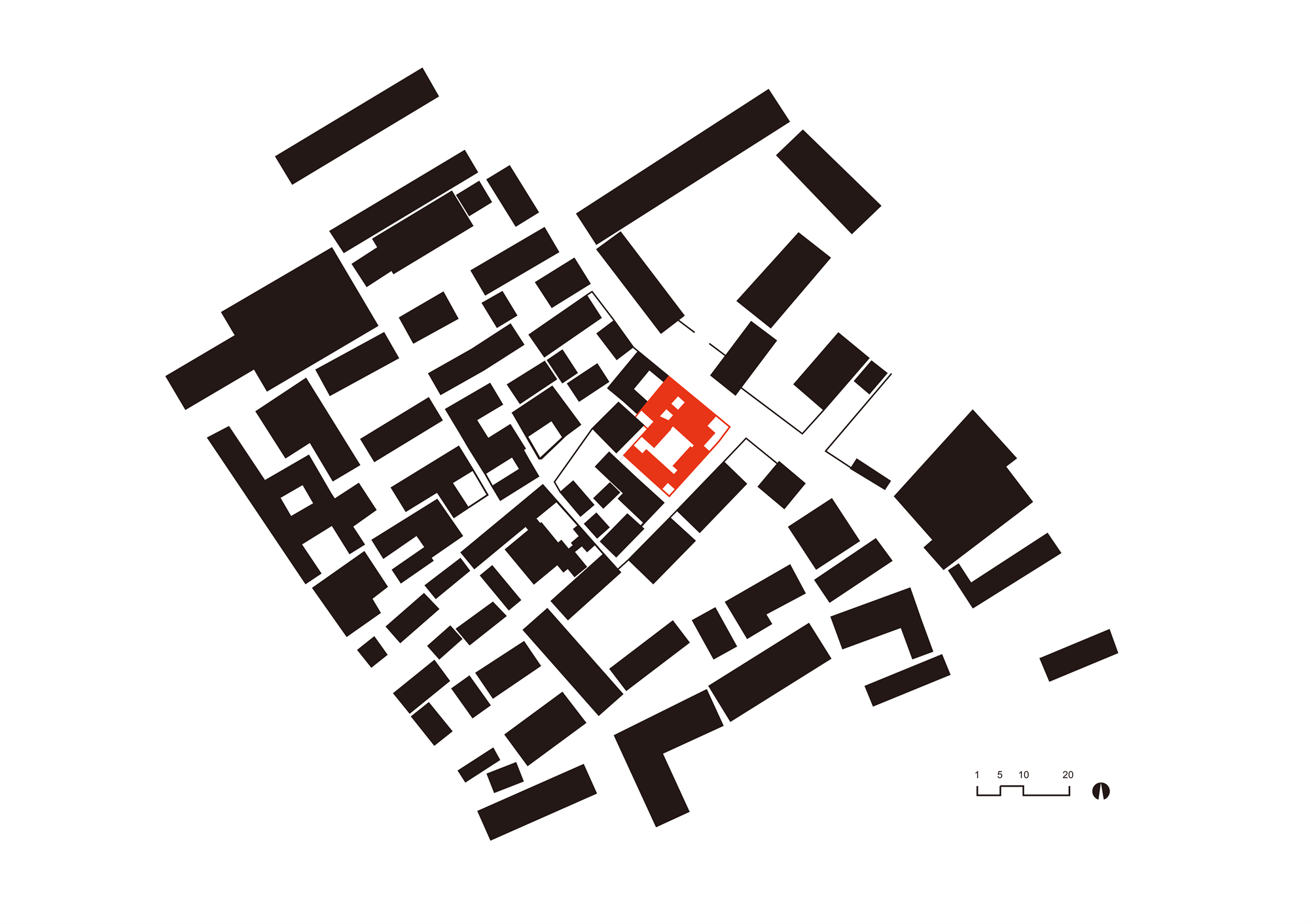

日军战败后,院子重新归属于原主人。家曾经变成监狱,监狱又变成家。后来,主人又全家搬进城市。院子中留下了不同时代人们生活的痕迹。
After the war, the government returned the house to its original owners. A home became a prison, and the prison turned back into a home. Afterwards, the entire family moved to the city, and the traces of lives from different eras remain.
围绕院子的建筑单坡屋檐向外,形制古怪。纵然周边山川开阔,无限风光,中心庭院却被高墙围在其中,困在阴影之下。四面围绕的建筑以中庭作为唯一采光来源,室内阴暗自不必说。
The new building was quite special, as a single sloping roof with lower eaves faced the outside. Although surrounded by natural beauty, the yard was enclosed by high walls and deep shadows, and as the only place which received any light, the circling houses were shrouded in darkness.

夏天我们拜访现场时,已有的建筑均呈现不同程度的破损甚至倒塌。但耸立的高墙之下,院中草木茂盛,环境透露出某种特别的气氛和质感。
When we visited the site in summer, although all buildings were in various stages of decay or had collapsed entirely, plants grew wildly in the yard and under the high walls and shadows. We could feel there exists a very special sense and atmosphere.
主人将弃置若干年的院子重建,当作度假别墅和待客之所。但现状这被高墙围合的场地,显然与医生主人对新房的想象大相径庭。
After being completely abandoned by the owners for several years, the houses would be rebuilt as a vacation home and guest house. However, the existent condition of the site was far different from what was imagined by the clients.

改造设计最简单的方式,是拆除破损的旧房,让场地另辟新章。
The most straightforward method in renovating the site was to demolish the existing environment and construct a completely new one.
但换个角度看,同样作为监狱,台伯河畔圣天使堡的剖面透露出不同的信息。其先后作为陵墓、监狱以及城堡,高墙也同时带来了某种庇护和安全感。
But from another prospective, the profile of Castel Sant'Angelo del Tiber, also a prison, reveals a different message, as successively a mausoleum, a prison and a castle, where the high walls also provide a certain shelter and security at the same time.


无论现实中(如圣天使堡),或者那些讲末世预言的幻想影剧(如《行尸走肉》第三季),在危机四伏的世界里,监狱反而充当了堡垒和庇护所。
Whether in reality (Castel Sant'Angelo) or in fantasy films or television (season 4 of Walking Dead), within a world in crisis a prison could also be a castle and shelter.
因此,任由这种独特的空间场景消失、斩断土地的记忆是令人惋惜的。在保持场地特征的前提下,设计变成如何策划一场“越狱”。
It would be quite regretful to completely make vanish the unique spatial scene, cutting off the memory of the land. So the design became a "prison break" while maintaining the characteristics of the site.
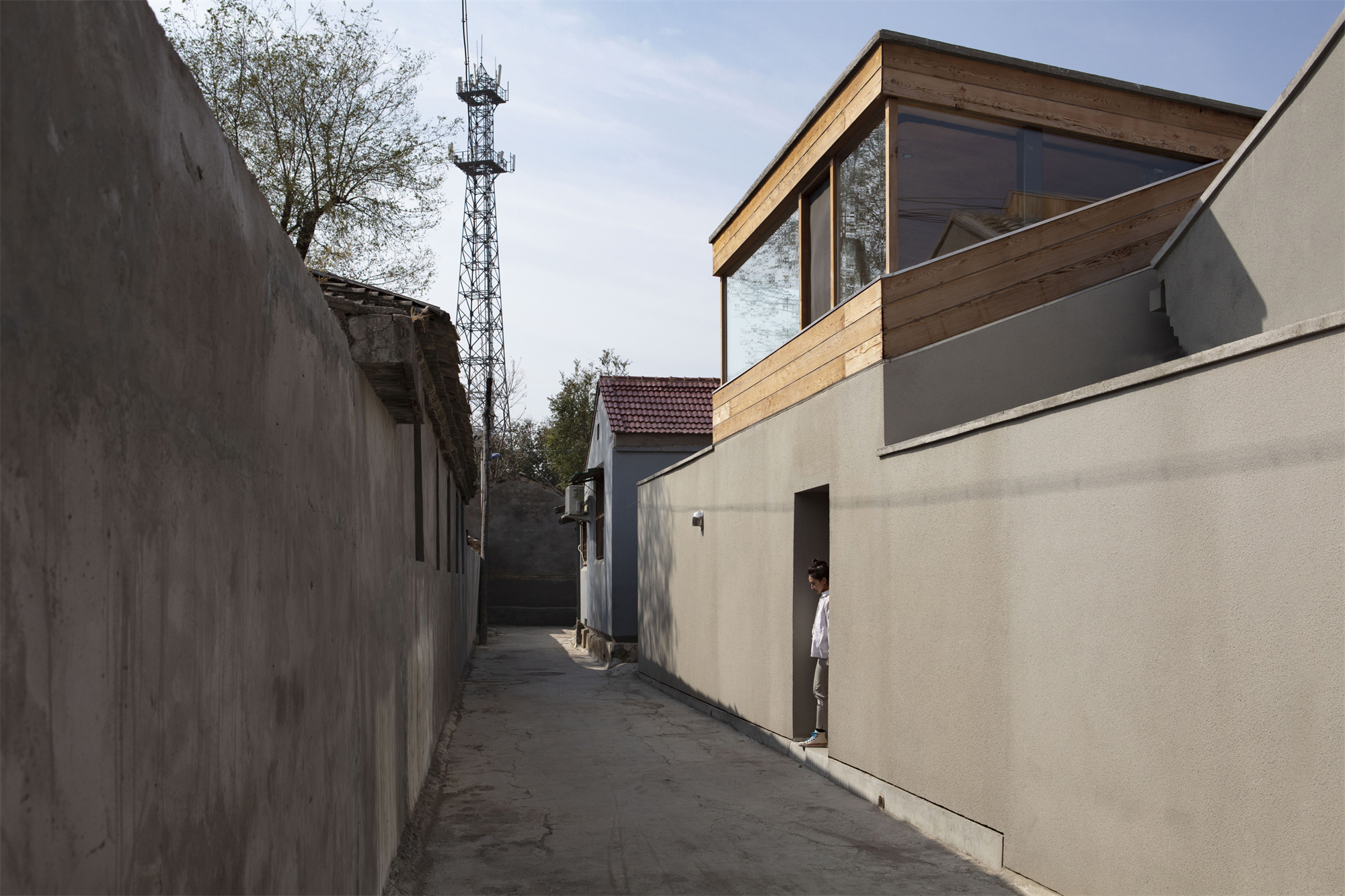

首先,我们对已有建筑中坍塌的部分落架重建,对倾倒和开裂的部分做结构加固。
We first rebuilt the building which had nearly collapsed, combined its own materials with a new steel structure, and kept the original form, strengthening the building which could still function.
在地面上,设计通过加建和连接,赋予新的秩序。
On the ground, we added new rooms as connectors to create new orders.

在高处,老房子上附着新的建筑:三个寄生的房子,我管它们叫“提篮”“手提箱”和“高脚柜”。它们扮演中介的作用,让日光、视线和人们的活动在墙里、屋顶上交互。这一系列动作,把高墙下的院子重新连接到周边的广大山川。
Above, three new structures were attached to the old building's roof and on top of those high walls. They are parasitic organisms, titled: "basket", "suitcase", and "cabinet", providing natural light and fresh air on the ground, as well as views and activities on the roof. In this way, the courtyard behind the high wall reconnected to the nature and surrounding fields.

院落边角和已有房舍之间的空间最先被占据,新建筑首层各自分离的区域变成“连贯的整体”。面向内庭院的立面被打开,大块玻璃代替了砖墙和细密的木格扇。
The space between the corners of the courtyard and the existing buildings is the first to be occupied, and the separate areas on the first floor of the new building become a "coherent whole". We opened the facade facing the inner yard, with large planes of glass taking the place of brick walls and wooden frames.
设计试图建立一个埋伏在高墙下的新系统。全天变换的光线通过连续的场所,在白墙间反射,带来更丰富的光影环境。即便头上的高墙依然存在,黑暗却变成了可以变换的灰度,明亮的大空间也随之而来。
The design attempts to create a new system buried beneath the high walls. The light that passes through the skylight changes throughout the day and is reflected between the white walls though a succession of places, bringing forth a rich environment of shadows and light. Even though the high walls remain overhead, the darkness turns into shifting shades of grey and the brightness of the large space follows.


公共场所居于连续变换的空间里,卧室则安排在尽端安静的角落,或架空的阁楼之上。角落里的卧室享有独立庭院,架空的卧室翻过高墙,获得了充足的日照和面向山川的景观。
In this continuously changing space, public spaces are located in the middle. Bedrooms are arranged in quiet corners at the far end, or on the second floor. The corner bedrooms enjoy their own yards. The second floor bedrooms are set back from the high walls and receive plenty of sunlight and views toward the mountains.


院落原来的入口较为偏僻,因此我们在南房临胡同的墙面上开辟了新的入口。来访者可以直接进入联通的室内。
The original entrance of the courtyard is in a remote corner. We opened a new one on the wall by the Hutong of the south building. Guests can directly enter the interconnected interior.
南房首层除了门厅,还在靠南的一排推拉门内暗藏了储藏室、设备间、洗衣房,和一个通向二层的楼梯间。
In addition to its function as a lobby, a row of sliding doors to the south conceals storage, an equipment room, a laundry room, and a stairwell leading to the second floor.


“手提箱”因着北侧的高墙在二层反向升起,翻过高墙,产生新的空间。远离首层的连续场所,它扮演了一个望向南面远方的客房。
The "suitcase", rises backwards from the top of the original high wall on the north side. With a distance from the ground floor public spaces, it is a guest room with a far view.

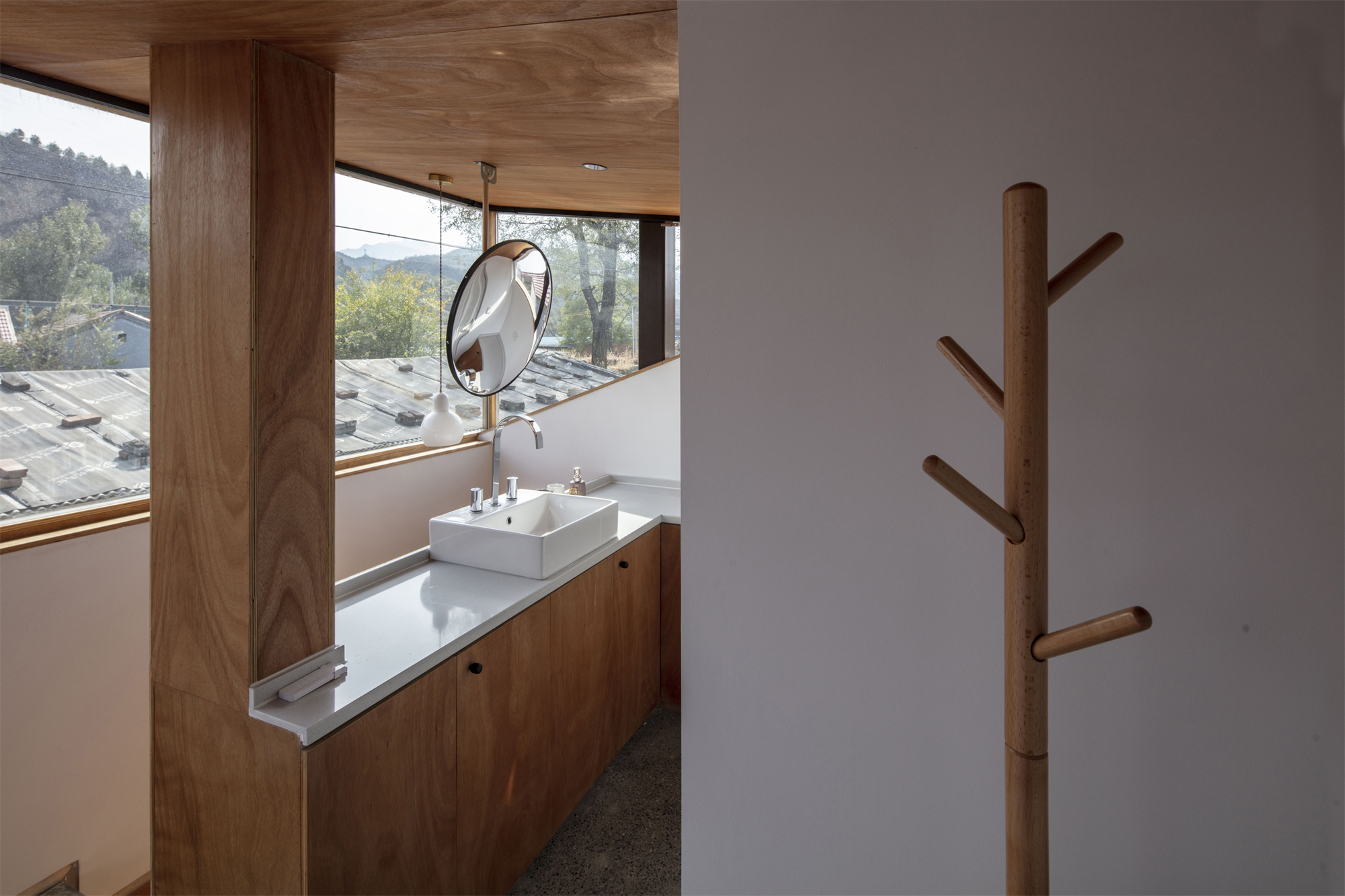
向北转入西房,这是整个公共空间的核心。大餐厅拥有最好的面对庭院的景观面,同时四通八达地连接到其他的区域。
Turning right and entering the west building through a corridor, this is the core site of public spaces. The large dining room has the best view of the courtyard and is well connected to the rest of the building.



东墙外的场地变成建筑的延伸,临街道的高窗下是开敞的厨房。
The site over the east wall becomes an extension of the building, with an open kitchen under a high window looking over the street.




厨房北侧楼梯引向屋面。新加建的钢结构“提篮”趴伏在东房屋顶上。被占据的老屋顶扩充了狭小的屋面面积。坡变成了梯台,人们可以倚着混凝土抛光的长桌,向东直面山川和沃野。
A staircase leads up to the roof. The steel structural "basket" lies on the roof of the original building. The old roof, which has been occupied, expands the limited area of the roof terrace. The slope has been transformed into steps, with a long polished concrete table facing eastward towards the mountains and fertile fields.


站在庭院里的人们,观察不到加建的“提篮”,却能看到屋顶活动的人群和种植的花草。
People standing in the inner yard cannot observe the addition of the "baskets", but can see people moving around on the roof.
梯台的侧面打开为玻璃采光带。白天天光打下来,屋顶老旧的木结构从黑影中被解救;夜间,灯光也由此外溢到屋面上。
The side of the steps appears as a glazed light strip. The old wooden structure on the ceiling is rescued from the dark shadows by skylights. At night, the light also spills out onto the roof from these same skylights.
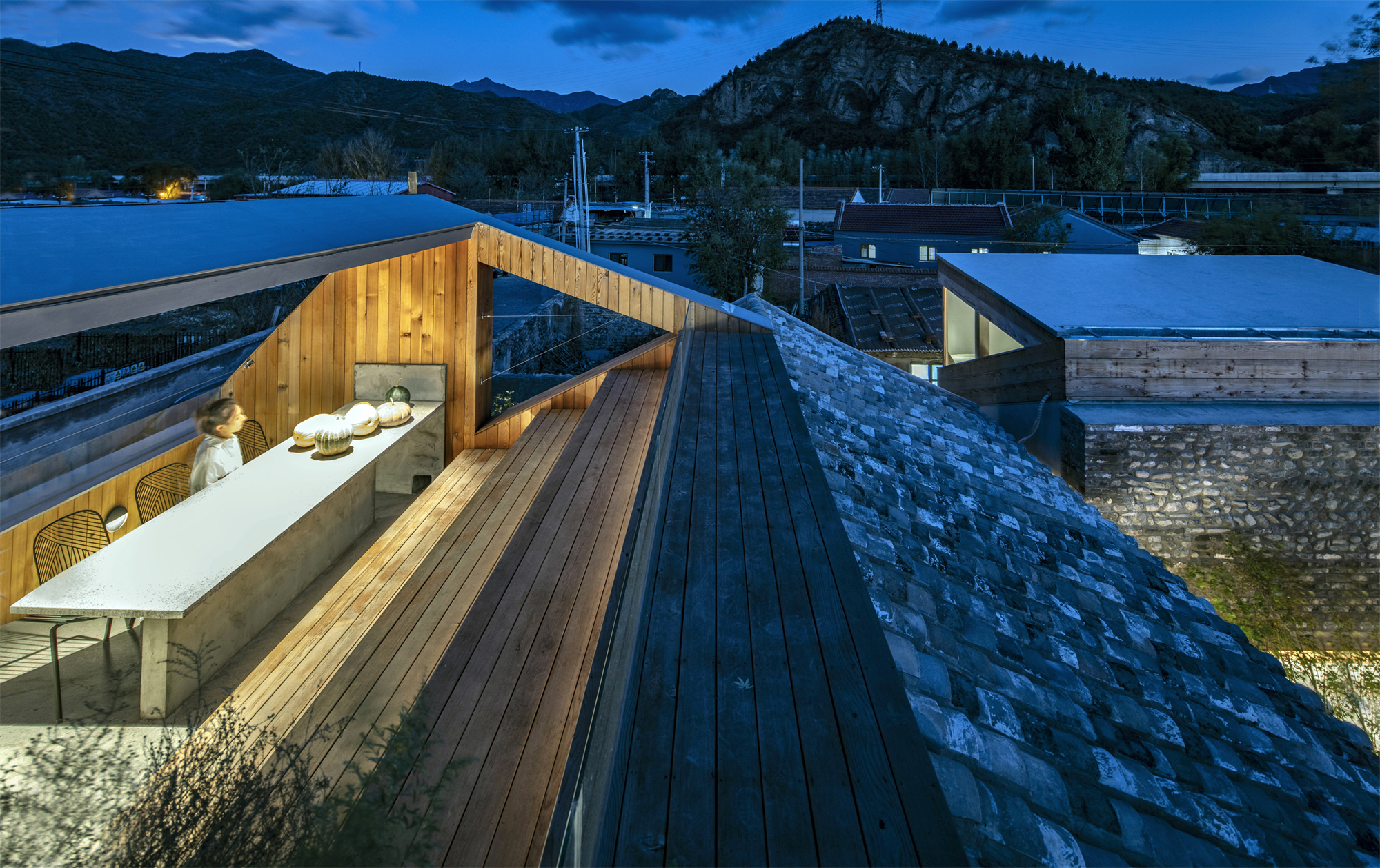

北房直接连接着东房,由于它曾经幸免于战火,是院中最古老的成员,我们仅仅替换掉它已经腐朽的木柱,重新铺设了屋面,并把向东倾倒的房子推回来,其他尽量维持原状。功能上,它成为大餐厅的补充,作为小客厅、书房和茶室。
The north room is directly connected to the east room and, as the most ancient member of the courtyard, that was once spared from the war, we simply replaced the rotten wood pillars, re-roofed the house, pushed back the neighboring building that had tilted to the east and kept the rest as original as possible, functioning as a complement to the large dining room, small library, and tea room.
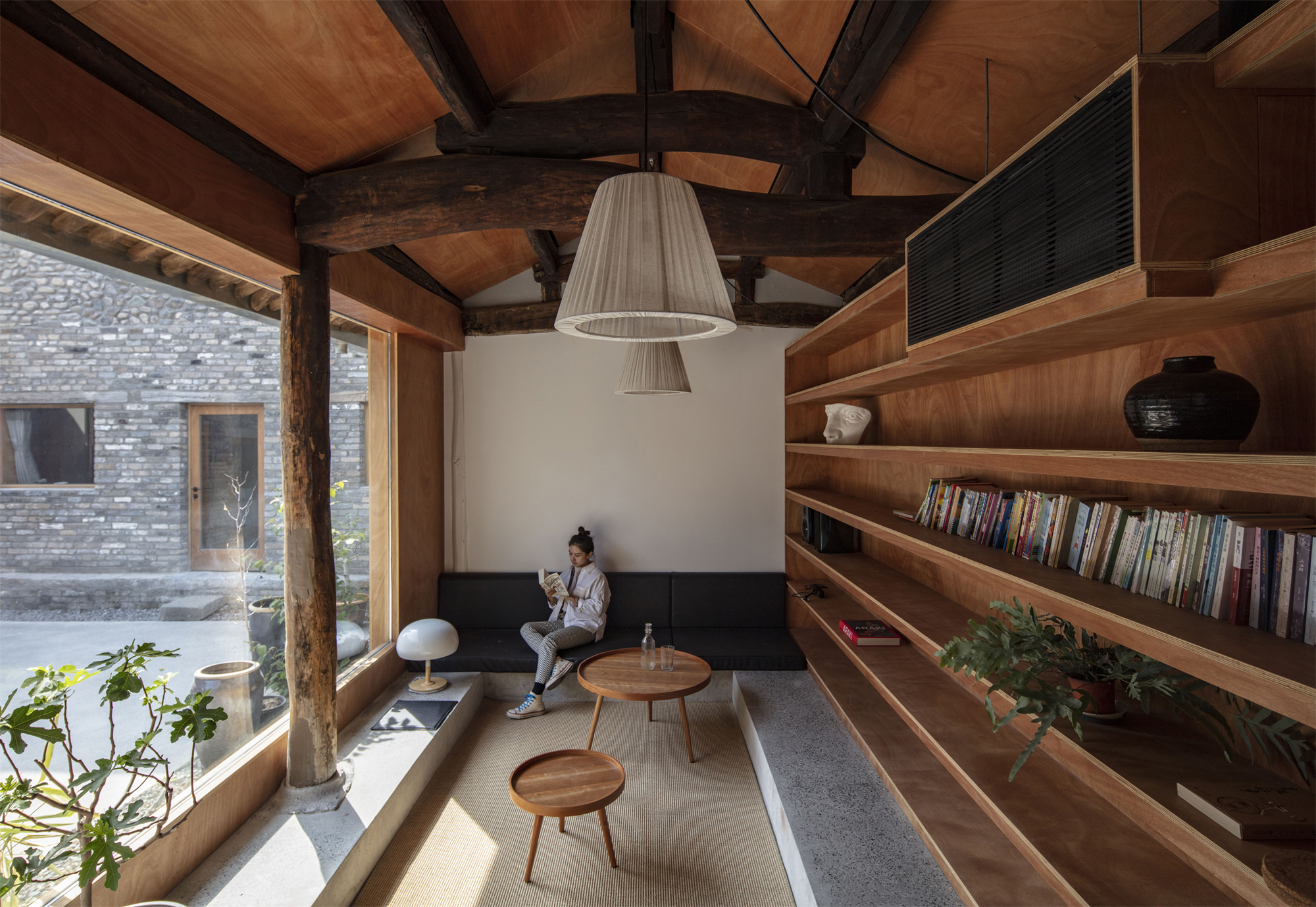

另一个尽端,西房“高脚柜”,承担多变的功能。一方面,其首层作为影音娱乐室,被当作公共空间的一部分;另一方面,在有较多访客留宿的时候,它也可变成临时的双层客房。
The west building located at the other end assumes a versatile function. On the one hand, the first floor is used as part of the public space, a movie room. The "cabinet" can also be used as a temporary bunk room when there are guests staying overnight.


预算非常紧张有限。我们依据照片记录,把原有砖石混砌的高墙立面重现出来。旧门楼、老影壁、北房屋面上的砖雕构件一概保留。
The budget was quite limited. Based on photographic documentation, we recreated the original brick and stone facade. The old gatehouse, screen wall and all brickwork on the face and roof of the north building have been preserved.
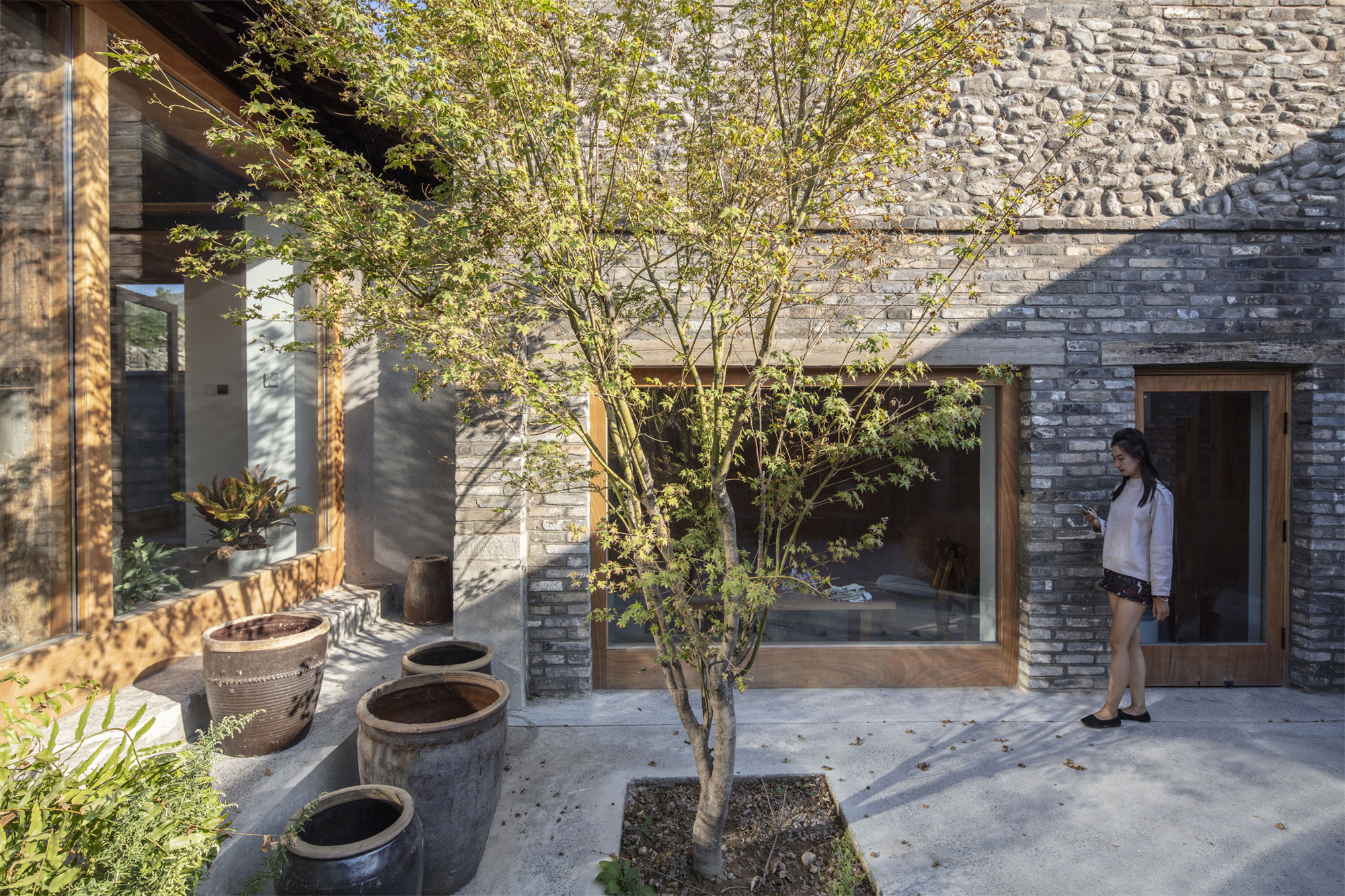
与旧建筑粗砺的质感相对应的,是新加建部分轻巧的钢结构、大片的玻璃和红雪松木饰面。
In contrast to the coarse texture of the old building, the new addition has a lightweight steel structure, large expanses of glass and red cedar veneer.

室内家具统一用较便宜的柳桉木多层板现场木作,地面用混凝土抛光完成。钢结构体积较小,施工迅速,较好地应对了复杂的场地现状。
The interior furnishings are uniformly made of cheaper willow eucalyptus plywood on site, and the floors are finished in polished concrete. The steel structure is relatively voluminous and was quick to construct, responding to the complexity of the sites' original state.



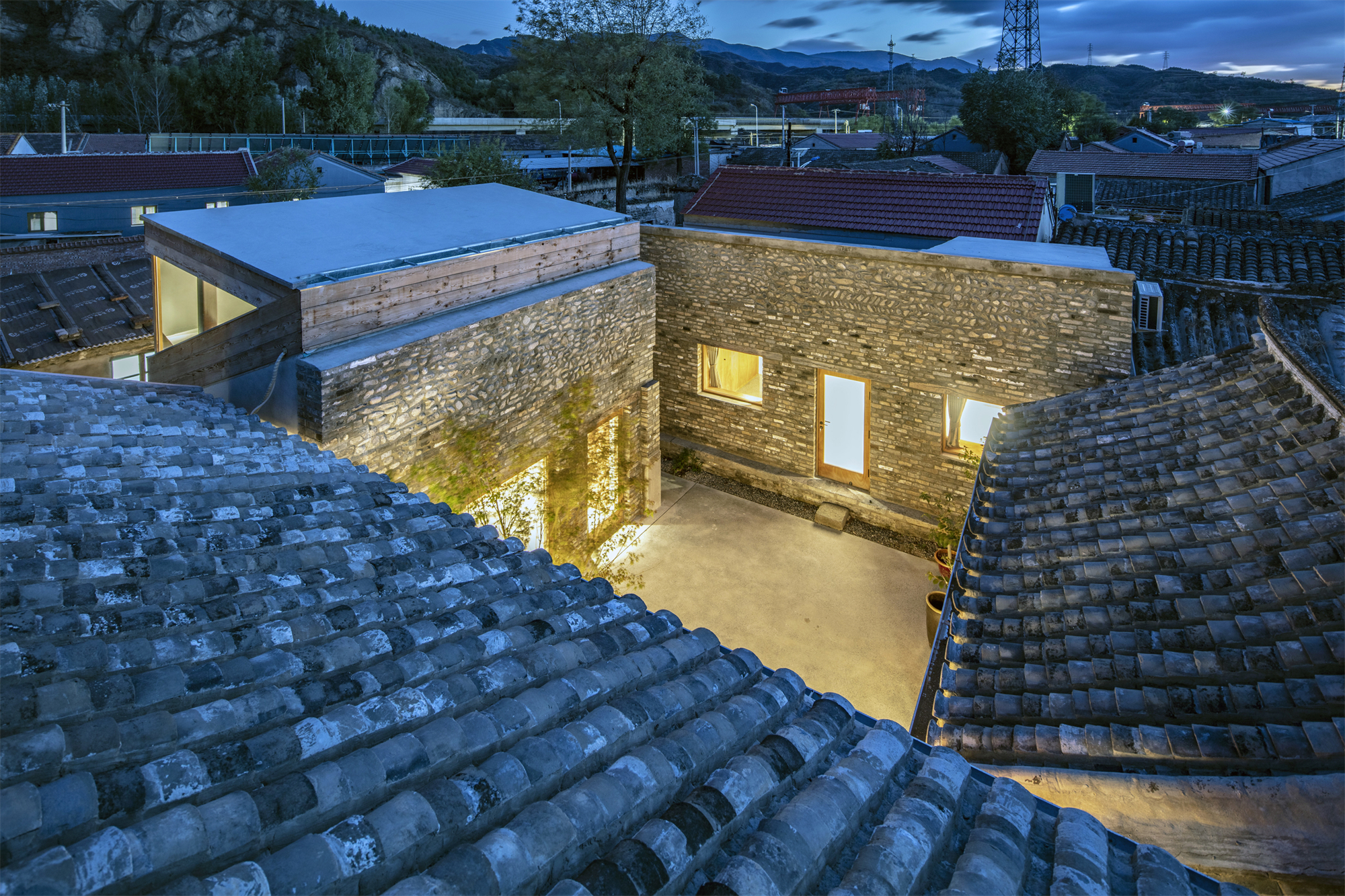

模型照片 ▽




设计图纸 ▽

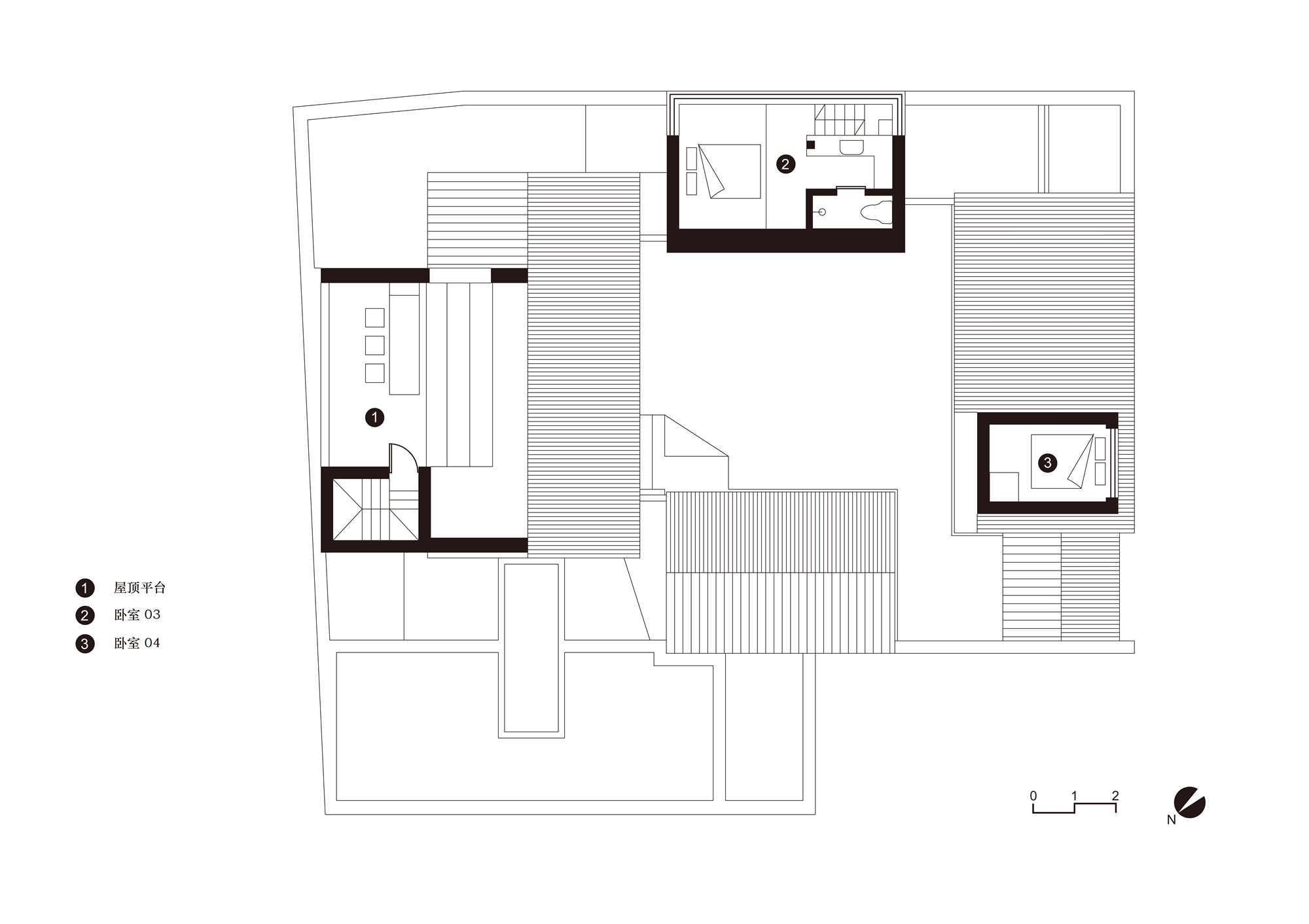






完整项目信息
项目名称:跳墙之家——良好的占据,和逃离一座监狱
项目地点:北京市门头沟区斋堂镇军响村17号院
设计单位:察社办公室
主创建筑师:成直
设计团队完整名单:成直、武迪、潘居豪
业主:刘亚欧、沈远
设计时间:2021年6月—2021年9月
建设时间:2021年11月—2022年7月
用地面积:319平方米
建筑面积:283平方米
结构:高雪梅
施工:张友江
摄影师:成直
本文由察社办公室授权有方发布。欢迎转发,禁止以有方编辑版本转载。
上一篇:福斯特事务所设计,毕尔巴鄂美术馆改扩建项目正式动工
下一篇:衢州礼贤未来社区安置房 | gad杰地设计